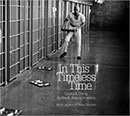In This Timeless Time: Living and Dying on Death Row in America

Authors: Bruce Jackson and Diane Christian
Publisher: Chapel Hill, NC: University of North Carolina Press, 2012. 256p.
Reviewer: Bonita M. Veysey | March 2013
Published in 2011, In This Timeless Time is the third in a series of works documenting Texas’ Death Row. The first two included a book, Death Row (1980), and a 60-minute documentary also entitled Death Row (1979), a copy of which is included with this volume. This book is comprised of three sections: “Pictures,” a set of black and white photographs of the Row and the men living there with brief narrative descriptions; “Words,” a section describing the context, including a discussion of death penalty legislation, death row housing and the procedures used by the Texas Department of Corrections for the execution of prisoners; and “Working,” a discussion of the interviewing and film-making process.
The 54-page “Words” section provides a concise overview of the death penalty legislation and research related to deterrence. The “Working” section is an interesting commentary on the difficulties of recruiting and gaining the trust of people who have very little reason other than sheer boredom to engage in the interviews, on the capriciousness of prison officials and rules, and the vagaries of conducting research in prison settings. While the written sections provide an important backdrop, it is the pictures (and video) that give life to the issue. The pictures poignantly portray men existing outside time… ever in a perpetual waiting room.
Of the approximately 100 men on death row at the time of the interviews, the pictures and interviews reflect only a handful of inmates. But even from this small group, the images convey profound messages. Existing in this “timeless time,” as one inmate expressed it, was unlike any other human experience, prison or otherwise. There is no expectation or hope for a future. Unimaginable is the long hours spent every day in a small cell for years. This dreary existence is conveyed through images of cellblocks, of men communicating between cells using mirrors, and of men simply standing behind bars and staring. Their faces are solemn or deadened, leaving the viewer wondering what thoughts lie behind those eyes. The only pictures that capture some happiness or satisfaction are all attached to the times when the men spend time together in the dayroom or playing volleyball in the tiny chain link exercise yard, or showing off their artistic gifts.
The thing about black and white photographs is that they can act as Rorschach images. Looking at the pictures over and over, I try to imagine what life is like for these men. I see them, Black, White and Hispanic, young and old, hardened and vulnerable, and wonder what life circumstances brought them to this place. By the authors’ report, they are no different than many serving sentences in the Texas system. So why are they in this place and others not? Is it poverty, psychosis, discrimination, or simply bad luck? And to what degree do the answers to these questions reflect the truth of these men or our own personal beliefs and biases?
Thinking about these things, it is then unnerving to discover what has happened to them over the past 30 years. Intimate pictures simply show (and describe in brief narratives) the twelve executed and the eight inmates who had their death sentences commuted to a prison term. Imagining who would be executed, who spared, and who exonerated, I was surprised by the knowing and also by my internal reactions.
While In This Timeless Time is not an academic book per se, it will provide readers and viewers a wealth of opportunities to reflect on the justifications for the death penalty, how it is applied and exactly the kind of existence to which we as a society condemn inmates under a death sentence to live.
Bonita M. Veysey, Ph.D., Rutgers University, School of Criminal Justice


